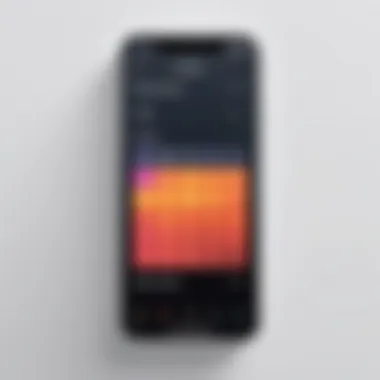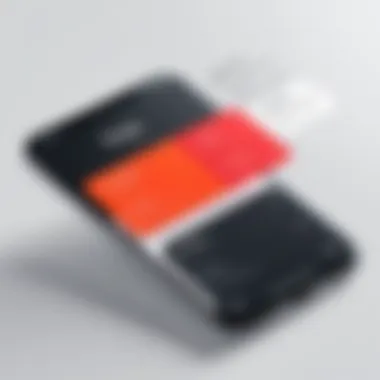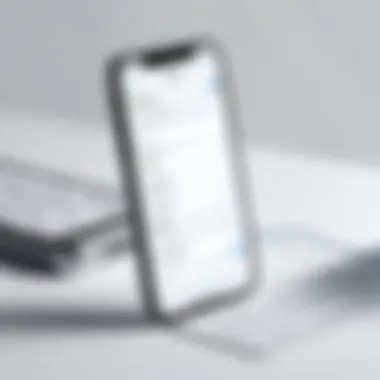Tracing Blocked Numbers on iPhone: A Comprehensive Guide


Intro
In today's digital age, it's not uncommon to receive unwanted calls and messages on our devices. For iPhone users, blocking unwanted numbers is an effective method to regain control over incoming communications. However, what happens when you need to trace these blocked numbers? Whether due to concern from repeated instances of harassment or simply needing to identify a missed call, understanding how to track blocked numbers can be invaluable. The purpose of this guide is to delve deep into the methods available for tracing these numbers on iPhone devices, addressing privacy implications, and enhancing user control.
> "Blocking numbers should empower users but also raises questions about traceability and privacy."
We'll cover the reasoning behind blocking numbers and the technical limitations inherent within the iPhone. Additionally, alternatives for tracking these numbers will be discussed, offering practical approaches for managing unwanted communications. Together, these components create a comprehensive framework that can aid in navigating this often-overlooked aspect of smartphone use.
Understanding Blocked Numbers
Blocked numbers play a significant role in managing communication on an iPhone. Understanding this concept is crucial for users who want to take control over unsolicited calls and messages. Many people find it necessary to block contacts for various reasons, highlighting the importance of understanding not only the mechanics of blocking but also the implications it has on user experience.
Definition of Blocked Numbers
Blocked numbers refer to contacts or phone numbers that a user has explicitly chosen to prevent from contacting them. When a number is blocked on an iPhone, any incoming calls, texts, or FaceTime requests from that number are automatically ignored. This means that the blocked caller will not be able to reach the user, and the user will not receive any form of communication from them. This feature is particularly beneficial in filtering out spam, unwanted marketing calls, or even from former acquaintances.
Reasons for Blocking Numbers
There are various reasons why individuals choose to block numbers on iPhone. Some common motivations include:
- Spam Calls: Many users experience persistent robocalls or telemarketing, leading to the need for blocking these numbers.
- Harassment: In cases where an individual feels uncomfortable due to repeated unwanted communication, blocking that number becomes essential for their emotional well-being.
- Personal Boundaries: For many, blocking is a way to maintain personal boundaries, especially from ex-partners or individuals who do not respect their wishes.
- Privacy Management: Some prefer to keep their communication channels strictly limited to known contacts, which often leads to blocking unknown or suspicious numbers.
In a world where privacy and personal space are increasingly prioritized, understanding blocked numbers is a fundamental aspect of managing one's digital interactions. The need and rationale behind blocking not only highlight individual preferences but also reflect a broader trend towards control over personal communications.
iPhone's Blocking Mechanism
Understanding the blocking mechanism on the iPhone is essential for users who seek to manage their incoming calls effectively. This feature is not merely about rejecting calls; it encompasses a robust system designed to enhance user privacy and communication control. Apple's implementation of this technology provides both benefits and considerations that are crucial for technologically savvy individuals. The ability to block numbers can prevent unwanted interactions, but it also raises questions about tracing those blocked numbers if needed later on.
Overview of iOS Call Blocking Features
Apple's iOS offers several features to block unwanted calls. Users can block numbers directly from the call log, messages, or contacts. Once a number is blocked, calls and texts from that number do not disturb the user. The following key features summarize how iOS facilitates blocking:
- Ease of Use: Block a number with just a few taps.
- Call and Message Filtering: Blocked numbers are not allowed to reach voicemail, nor can they send text messages.
- Policy on Unknown Callers: Users can silence calls from unknown numbers, sending them straight to voicemail.
This intuitive interface allows users to manage their communications without extensive technical knowledge.
How Blocking Works on iPhone


The technical workings of the iPhone's blocking feature involve a straightforward approach. When a user decides to block a number, the iPhone essentially tells the operating system not to process any incoming communication from that specific number. Here is an outline of how this blocking functions:
- Number Registration: The blocked number is registered in the user’s settings.
- Call Filtering: The phone detects incoming calls from the blocked number and bypasses the phone's usual ringing or alerting system.
- Message Filtering: Text messages from that number are prevented from being delivered.
Overall, these mechanisms ensure that users enjoy a quieter experience, cutting off communications they deem unnecessary or undesired. However, it is essential to note that while blocking offers a solution to unwanted interactions, it also complicates the tracing process, which will be discussed in later sections.
Limitations in Tracing Blocked Numbers
Understanding the limitations associated with tracing blocked numbers on iPhones is crucial for users who seek clarity and control over their communication channels. Though the intent to trace a blocked number might stem from personal security concerns, unresolved matters, or simple curiosity, the technical landscape presents certain barriers. Grasping these limitations helps in managing expectations and highlights the importance of leveraging legitimate methods in navigating privacy policies and technical guidelines.
Technical Restrictions of iPhone
The iPhone employs a sophisticated blocking mechanism. When a number is blocked, calls and messages from that contact are effectively silenced. Users will not receive any notification of incoming calls or messages once a number is blocked. This built-in functionality prioritizes user privacy but does come with limitations.
One significant aspect of these restrictions is that iPhones do not store any call logs from blocked numbers. As a result, users cannot access any information related to attempted communications from these contacts. This intentional design element is meant to protect users from unwanted interaction, yet it poses a challenge for those who may wish to know more about blocked contacts.
Another limitation involves the inability to trace calls made from hidden numbers or numbers that are not identifiable. If a blocked number uses caller ID suppression, the technical systems cannot provide any details, further complicating tracing attempts.
Why Tracing Can Be Challenging
Tracing blocked numbers can be notably complex due to various factors inherent in telecommunication practices and user privacy protections. The primary obstacle arises from the ethical and legal principles that govern tracing activities.
Many users may not consider that even if a number is blocked, it could still attempt to reach the device. However, the system treats these inputs as entirely non-existent due to the blocks in place. Therefore, users cannot easily determine why a contact was blocked or trace their activities without prior knowledge.
Moreover, the reliance on third-party applications may provide limited solutions. Many apps claim to reveal blocked contacts, yet their results can be inconsistent or unreliable due to the current restrictions imposed by Apple. Users may find themselves in search of effective methods but could end up with more questions than answers.
For those who value transparency and accountability in communication, the restrictions present a profound dilemma. It is essential to be informed about the existing capabilities and restrictions in order to make educated decisions regarding blocked numbers.
Alternative Methods to Trace Blocked Numbers
Tracing blocked numbers on an iPhone device is often a challenging task due to the built-in privacy features designed to protect users from unwanted communication. However, alternative methods exist for those determined to uncover information about these numbers. This section will explore various techniques, emphasizing third-party applications and carrier services.
Using these methods can provide insights into previously blocked contacts. It's important to note that while these techniques may yield results, they could also come with implications regarding privacy and data handling. The benefits of employing alternative methods include the potential to regain control over one's communications and the ability to manage blocked numbers with more insight.
Using Third-Party Applications
Third-party applications offer one of the most popular avenues for tracing blocked numbers. Many apps are designed with features that help users identify unknown callers, even if they have been blocked.


When assessing these applications, several elements should be considered:
- Functionality: Look for apps that provide reverse phone lookup services, call logging, and caller identification features. Examples include Truecaller and Hiya.
- User Reviews: Check reviews and ratings to gauge the reliability and effectiveness of an app.
- Data Privacy: Understand how the app handles personal data. Make sure its policies align with your preferences about privacy.
The process typically involves downloading an app and setting it up on your device. Once configured, the app can notify you of incoming calls, even those from blocked numbers, provided the information is available within its database.
"Users should remain vigilant about the permissions granted to third-party apps to maintain their privacy and security."
Carrier Services for Tracing
Another practical method to trace blocked numbers is to contact your mobile carrier. Most carriers provide services that can assist in identifying blocked or unknown numbers to some extent.
Key considerations when using carrier services include:
- Service Availability: Not all carriers offer comprehensive tracing services. Verify if your carrier supports features for tracing blocked numbers.
- Charges: Be aware that some carriers may impose fees for these services. Clarifying any costs before proceeding ensures there are no surprises.
- Privacy Policies: Understand how your carrier uses the data you provide. This insight will help maintain a comfortable balance between information access and privacy.
In many cases, reaching out to customer support can provide you with options to access number tracing features. This route is especially useful for users who prefer to keep interactions with tech solutions minimal.
Managing Blocked Contacts
Managing blocked contacts is essential for maintaining clarity in your communication. While blocking numbers may serve as an effective shield against unwanted disturbances, it becomes necessary to revisit these decisions periodically. Approaching the management of blocked contacts can enhance your phone experience and provide opportunities to restore important connections.
Reviewing Blocked Numbers
In order to manage your blocked contacts effectively, reviewing the list of blocked numbers is a critical step. This action allows for understanding any reasons you may have blocked certain numbers initially. For example, it might have been due to unsolicited calls, spam, or even personal disagreements. By examining these numbers, you can reevaluate whether they still deserve a place on the list.
To access your blocked contacts on an iPhone, navigate to Settings, then scroll down to Phone and select Blocked Contacts. This list will present every contact currently blocked, along with their respective numbers. Here are some considerations when reviewing these contacts:
- Is the reason for blocking still valid? Sometimes situations change, and a number no longer represents an issue.
- Were the blocks made inadvertently? A typo in a number can result in blocking someone important unknowingly.
- Are there any important communications missed? Consider if any crucial calls have gone unanswered due to an earlier block.
Regularly reviewing blocked numbers optimizes communication and creates an opportunity to foster important relationships.
Unblocking Contacts
If you determine that a contact deserves to be unblocked, the unblocking process is straightforward. Begin by accessing the same Blocked Contacts list in the Phone settings. Locate the specific number or contact you wish to unblock. Simply swipe left on the contact's name and select 'Unblock' or tap 'Edit' and then click the red minus sign next to the number to remove it from the block list.
It is important to consider the implications of unblocking any contact. Keep in mind:


- Re-establishing Communication: Unblocking allows for renewed interaction. Ensure that you are ready for potential communications from that number.
- Spam Risks: Remove unwelcome numbers if they turn out to be spam or recurrent invitations.
- Emotional Factors: Some contacts may have personal significant meaning. Think carefully about your decision to unblock or block again.
In summary, managing blocked contacts not only preserves your peace of mind but also facilitates a healthy communication realm. Engaging with this process brings better contact management, ultimately improving your user experience.
The Role of Privacy in Blocking
In today's interconnected world, the role of privacy in blocking calls and messages has become increasingly significant. With technology advancing at such a rapid pace, users often find themselves bombarded with unsolicited communications. This has led to a heightened awareness of personal privacy. Users must understand that blocking numbers is not just about avoiding annoying calls; it is also about protecting sensitive information and maintaining control over one's digital environment.
Understanding Privacy Concerns
Understanding privacy concerns involves recognizing the delicate balance between personal security and the need for communication. When a user blocks a number on their iPhone, they exercise their right to control who can reach them. Blocking unwanted numbers can prevent scams, spam, or even aggressive marketing tactics that may compromise personal information. Recent statistics indicate that a significant percentage of mobile users are highly concerned about their privacy and the data that companies may gather through unsolicited communications.
Several aspects to consider include:
- Data Sharing: Sometimes, blocked contacts may still have access to your data through mutual contacts or social media platforms like Facebook.
- Impact on Relationships: Blocking someone can significantly impact personal relationships, and it can lead to misunderstandings. Users should be aware of the potential social implications when deciding to block a number.
- Mental Wellbeing: A cluttered communication channel, filled with unwanted calls or messages, can lead to stress. Thus, controlling incoming communications can lead to improved mental health.
"Privacy is not something that I’m merely entitled to, it’s an absolute prerequisite." — Marlon Brando
Legal Implications of Tracing Blocked Numbers
Legal considerations play an important role in the discourse on tracing blocked numbers. While it might be tempting to search for information about blocked contacts, users must navigate a complex web of laws and regulations. The right to privacy is fundamental in many jurisdictions, and tracing a blocked number can infringe upon that right.
Key legal implications include:
- Consent and Permission: Tracing a blocked number often requires the subject's consent. Engaging in tracing without permission can lead to legal repercussions.
- Regulations: Different countries have various laws surrounding privacy and data usage. In the United States, for instance, the Telephone Consumer Protection Act sets limits on robocalls and unwanted telemarketing.
- Potential Consequences: If a tracing method violates privacy laws, individuals could potentially face lawsuits or fines. It's crucial for users to understand the local legislation before attempting to trace a blocked number.
In summary, the role of privacy in blocking encompasses a range of considerations, from personal security to the legal framework surrounding communications. As technology progresses, users must remain vigilant about their privacy rights and the potential implications of tracing blocked numbers.
End
The conclusion of this article highlights the critical aspects of tracing blocked numbers on iPhone devices. Understanding how to manage and potentially trace blocked numbers is essential in today's digital communication landscape. Users often face various challenges when dealing with blocked contacts. This can be due to personal reasons, professional dismissals, or unwanted solicitations.
Addressing the reasons behind blocking numbers offers insights into the emotional and practical motivations of users. Recognizing these motivations not only fosters empathy but also aids in addressing unresolved communication issues. Furthermore, this guide articulates the technical boundaries that iPhones impose. Knowing these limitations can help users set realistic expectations.
Final Thoughts on Tracing Blocked Numbers
While technology has advanced significantly, tracing blocked numbers on an iPhone can still be problematic. Users must realize that privacy is a two-way street. It’s essential to think of the legal implications related to attempts to supersede someone’s blocked status. Understanding the balance between curiosity and respect for privacy is crucial.
Each method explored in the article, whether using third-party applications or seeking assistance from carrier services, comes with its own set of advantages and risks. Ultimately, users should prioritize their needs and the necessity to maintain their security and privacy. The key point is to adopt a measured approach while navigating this area. Here are some takeaways:
- Reflect on the reasons for blocking. Understanding motive can provide clarity.
- Be aware of the limitations. Familiarity with the iPhone's capabilities aids in managing expectations.
- Consider privacy implications carefully. Respecting others’ boundaries is as important as understanding one's own communication goals.
In summary, navigating through the complexities of blocked numbers requires a blend of technical knowledge and a considerate mindset. This guide serves as a foundation for those who seek to enhance their communication experience, reminding all users of both their rights and responsibilities.
"Privacy and respect should be our guiding principles in communication."



